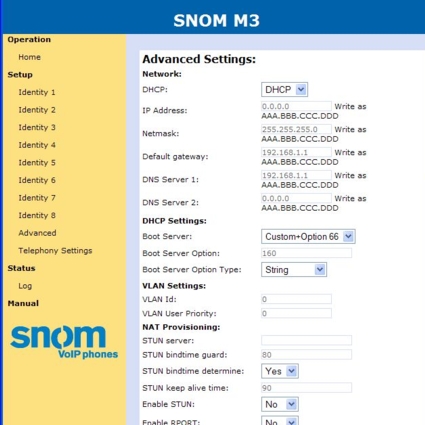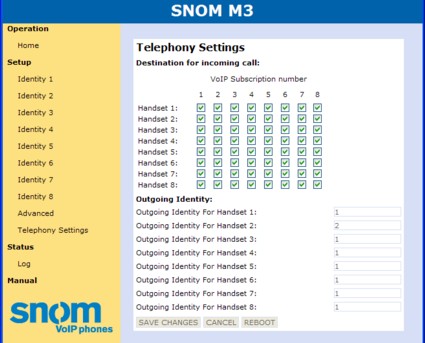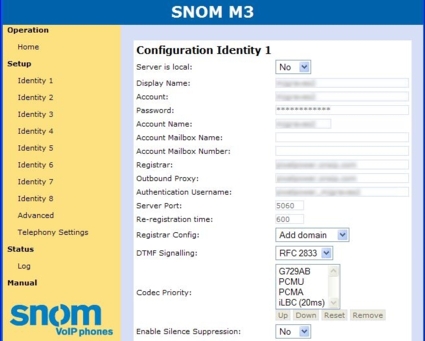Introduction
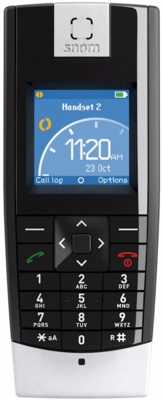
| At a Glance | |
|---|---|
| Product | snom m3 IP DECT phone |
| Summary | Full-featured business-class cordless IP phone system |
| Pros | • Easy setup • Very good call quality • Good cordless range • Excellent battery life • Multiple simultaneous SIP registrations |
| Cons | • Contact list not remote provisioned • No use of SIP URIs • No dedicated function keys • No support for G.722 • Weak speakerphone |
I have worked from a home office for over ten years. Just over two years ago, I transitioned both my home and office to a completely VoIP-based phone system. My goal was to improve my ability to stay connected while reducing my monthly operating costs. I carefully selected high quality, business-class SIP desk phones with a variety of features to make running a small office easier.
This conversion went very well with one exception: it lacked a well-integrated SIP-based cordless phone solution.
I began by using a traditional cordless phone and an analog terminal adapter (ATA). This worked passably, but didn’t deliver the features (multiple lines, hold, transfer, call waiting, conferencing, etc.) that I’d grown to rely upon in my wired IP phones.
Next, I tried a couple of the newer Wi-Fi SIP handsets. These were disappointing as well. While better able to integrate with the other phones, they suffered a great many problems: poor battery life, short range… and too many more to mention.
Therefore, when in late in 2007 I read that snom was introducing a professional SIP/DECT cordless phone system, I was eager to see if this would be the solution I’d been seeking. I was fortunate enough to acquire an m3 system from the very first shipment imported into the US.
snom is a well-established German maker of SIP desk phones. The m3 is their first effort at a cordless phone. While some companies have tried to leverage Wi-Fi network infrastructure to implement cordless phones, the results have not generally been satisfactory for business and professional applications.
In the design of the m3, snom has combined the European DECT cordless technology with VoIP connectivity based on the widespread SIP standard. This puts the m3 in the vanguard of a new wave of cordless VoIP phones.
What is DECT?
Digital Enhanced Cordless Telecommunications (DECT) is a wireless communication standard that evolved in Europe over the past twenty years. DECT technology can be used for wireless data networking, but is most typically used in cordless phones.
The DECT standard specifies a range of things about how cordless handsets and base stations interact. The most common DECT profile is the Generic Access Profile, a.k.a. GAP. GAP compliance allows devices from various manufacturers to work together seamlessly.
One of the nicer features of DECT is the ability to seamlessly hand off calls as a handset moves between multiple base stations in a large facility. This can be a tremendous benefit when trying to provide uniform cordless phone coverage in large office buildings or warehouses.
Until recently, most cordless phones in North America, including a limited number of DECT systems, used the very congested 2.4 GHz unlicensed band, which is the same frequency as Wi-Fi 802.11b networking devices. This often led to interference between cordless phones and Wi-Fi networks. In contrast, European DECT devices use the 1.9 GHz band—well below Wi-Fi networks—eliminating the interference problem.
In 2005, the FCC amended regulations governing licensing of the 1.9 GHz band. This cleared the way for the sale of DECT 6.0 devices in the US. Looking at major retailers, we see DECT systems quickly displacing older, proprietary systems. Major players in this space include Polycom, Aastra, Panasonic, Uniden, Philips, and Siemens, among others.
Unpacking: The Base and Handset
The basic m3 package consists of one base, one cordless handset, and one charging stand, as seen in Figure 1. For the purposes of my review, I added an extra cordless handset so that I could have one in my home office and another in my home. Each extra handset includes its own charging stand. The system supports up to eight handsets, although one base can only handle three simultaneous calls.
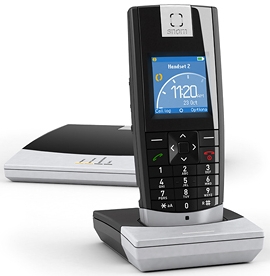
Figure 1: Basic m3 package: base, handset, and charging stand
The base station is an attractive, flat, 7″ square-ish device with chrome trim. It has only two connections: an RJ-45 jack for Ethernet, and a socket for the AC adapter. On its front edge, there are four status LEDs indicating power, network connectivity, SIP registration, and call activity.
The bottom of the base has holes for mounting vertically on a wall if desired. Since the base has an internal antenna, mounting it high on a wall could be helpful in increasing the useful range of the system. Given that there are literally no adjustments made on the base, it can be mounted with greater regard for RF performance than ease of access.
The handsets are about the same size and weight as a common cell phone. They sport a 1.75″ color LCD display, 2.5mm headset jack, and speakerphone capability. The design is simple, attractive, and elegant.
The handset case is plastic, with the exception of some chrome trim near the earpiece. They appear to be more at home in an office space than on a factory floor. Even so, the phone feels solid, and in a month of heavy use, a handset has bounced off a carpeted floor at least once without breaking. A flat stubby antenna sticks up ¾” from the top of the handset.
The belt clip betrays the care taken in the design of the handset. It clips firmly onto the handset, and stays hooked onto a belt or pocket, even while I was actively mounting heavy servers while on a call.
The headset jack is also a welcome feature. I frequently attend long conference calls, during which I need my hands free. To accommodate this, I prefer to have the handset clipped to my belt and wear a wired headset.
The m3 comes with a small but reasonably complete printed manual. Greater detail can be found at the snom wiki, a link to which is included on the web interface. The wiki includes the provisioning documentation necessary to roll out the m3 in a corporate enterprise environment. The m3 is a brand new product, so some areas of the wiki have not been completed.
Installation and Setup
The initial configuration was startlingly simple and quick. From applying power to making the first phone call was less than five minutes.
On power-up, the phones seek out and automatically establish connections to the base station. If the base is rebooted, the handsets quickly reestablish their connections once the base is back online. This process is fast and completely automatic.
By default, the base station gets an IP address from your local DHCP service. From the handset, you can determine the IP address assigned to the base by pressing volume up once. This brings up a status display on the handset that tells you the system’s MAC address, IP address, and software version. Once you know the IP address of the base, you can access its web-based management portal to go through the system configuration.
The management portal is password protected. The very first thing that you should do when you log in is visit the Advanced Settings page (Figure 2) and change the default login and password to something suitably secure.
Figure 2: Advanced settings page on the web interface
For those who prefer not to use a computer, it’s possible to make all the initial settings on the handset itself. However, it can be a bit tricky entering SIP account details, passwords, etc. I prefer using the web interface, but it’s good to have another option.
Setup – more
The system allows for the setup of up to eight “Identities,” each of which is a login to a SIP registrar. For my initial testing, I entered login details to an account with Junction Networks’ OnSIP hosted IP-PBX service. The phone registered in just a few seconds and was immediately able to make and receive calls. No other setup was required, even though the snom was behind a NAT router with a private IP address.
The Telephony Settings page on the web interface (Figure 3) lets you decide which identity each handset will use when making calls. It also lets you define which handsets will ring in response to incoming calls for each identity.
Figure 3: Telephony Settings on the web interface
This ability to map accounts to handsets makes the system very flexible. You can send outgoing calls to your preferred service provider while continuing to accept calls from a number of accounts. In my case, I registered with two separate hosted PBX accounts (home and office lines), then also registered with my local Asterisk server.
It’s easy to see how a large household or office might assign each member of the family or office their own private line that rings to their own extension. Yet when placing a call, the caller ID would reflect the master number, regardless of from which extension the call was placed.
Network Setup
One of the more common difficulties with SIP-based VoIP is getting everything to work while passing through routers and firewalls that perform Network Address Translation (NAT.) The VoIP community has developed a number of techniques to overcome this problem in the hope of making SIP setup easier. One such technique is known as Simple Traversal of UDP through NATs, or STUN.
The m3 includes STUN capability, although I didn’t need to use this to register with most of the providers I use. However, by enabling the STUN feature, I was able to get the m3 to work with Free World Dialup, one of the earliest and largest online SIP user communities.
In fact, I was able to get the m3 to work with a number of SIP service providers, including: Asterisk (Astlinux 0.48), Junction Networks/OnSIP, VoicePulse Connect, Free World Dialup, and SIPphone/Gizmo Project.
Based on this experience, it would be reasonable to expect that it could be used with any SIP provider.
snom has a history of providing SIP phones that fit well into small and mid-sized businesses. That includes that ability to mass-provision and configure devices from a central server. The m3 has this capability as well, relying upon either HTTP or TFTP servers for loading firmware and configuration files.
That said, most SOHO users will never need a provisioning server. When a new release of firmware is available, they can provision the phone via HTTP from one of snom’s servers.
Codec Support
The m3 supports the most common VoIP codecs, including G.711a, G.711u, G.729a, and ILBC. Codec availability and preference is set up on a per-identity basis (Figure 4).
Figure 4: Codec settings can be configured for each identity
G.711 is the standard voice codec used by most of the telecom industry. It’s the basis of all traditional phone systems and the baseline by which call quality is measured. G.729a and ILBC are low bit-rate codecs that will help you get the most out of the upstream side of an ADSL service, although with a slight loss in call quality.
A G.729a-encoded call requires 32 kbps per call leg, versus 80 kbps for G.711a/u-encoded calls. G.729a is very common in the telecom industry and accepted by many commercial VoIP providers. As a rule, I use this codec with my hosted IP-PBX.
It would have been nice to have support for the newer G.722 wideband audio codec. Sometimes called “HD Voice,” this new codec offers outstanding call clarity through the use of a 16 KHz sampling rate. Such call quality is only possible when both ends of the call support the G.722 coding scheme. This limits the possibility of its use to a handful of newer IP phones. Of course, the call would need to pass between the phones as IP traffic end-to-end, without touching the PSTN.
In Use
For the past month, I have used an m3 as my primary phone when away from my desk. The call quality has been as good as any cordless phone I’ve heard, and much better than any Wi-Fi SIP phone I’ve tried.
One problem that I’ve often encountered in other handsets is their limited range of volume. The m3 earpiece was adequately loud, but I did keep it set near maximum volume most of the time. The same was true when using a wired headset. A little more volume would have been handy when working near noisy servers.
The handset also has speakerphone capability that is engaged by a small square button on the left side of the phone. I found that the speakerphone was not very clear and so not especially useful. To be fair, I much prefer to use a dedicated Polycom speakerphone when the situation warrants that type of device.
In general, I think the m3 menus are rationally designed (Figure 5). Most common functions are easily accessible when needed. Access to core settings is protected by a 4-digit pass code, which should be enough to safeguard against curious kids and coworkers.

Figure 5: The m3’s main menu screen
As I frequently attend long conference calls, I was happy to see the mute function on the left soft key when a call is in progress. Conference calls can be a lot more productive if attendees are diligent about muting their microphones when not speaking. This simple act of courtesy minimizes background noise and distraction for everyone on the call.
Mimicking the design of a cell phone, there are a limited number of buttons on the m3 handset. I can only wish that manufacturers would take a cue from older cordless phones that use dedicated buttons for functions like hold/resume, transfer, conference, etc. While the extra buttons might make for a slightly larger handset, the increase in usability would make it worth the size difference.
Call Logs and Contact List
Many of the m3’s features clearly follow the menu model established by cell phones. The phone’s call log is a good example of this. The call log is accessed by pressing one button from the main menu. Calls are indicated as incoming, outgoing, or missed. With another key press or two, the list can be filtered to show only one call type at a time. This proved very handy for quickly returning missed calls.
Entries from the call log are easily moved into the m3’s internal contact list (Figure 6). Each contact can have four numbers, corresponding to Home, Office, Mobile, and Other. Contacts can be grouped, and different ring tones assigned to each group.

Figure 6: Adding contacts from the Call Log is easy
Each handset may have its own contact list, or all the handsets may share a common contact list. The contact list allows for 170 entries. Entering contacts on the handset is straightforward, with the * key serving to shift between entering upper case, lower case, or numbers.
Presently, there isn’t a way to provision the contact list from an external source. I would hope that a future release of firmware would make this possible. It would be useful to be able to enter contact details via the web interface, or load them from an XML file on the provisioning server. snom’s desk phones have this capability, so there is an established precedent; however, multiple handsets with separate contact lists could make this feature a bit more complicated to implement.
Battery Life and Range
One of the most common failings of Wi-Fi SIP phones is poor battery life. This is not entirely the fault of the phones. The radios used in Wi-Fi are designed for optimum network performance and reliability, not conservation of power. In contrast, the DECT standard provides for close management of power consumption.
The m3 includes a Lithium-Ion battery to further maximize battery life. snom claims eight hours of talk time and 100 hours of standby time. My experience has been that I can leave an m3 off its charging stand and use it heavily for two days, and still have 25% of battery power remaining. This is much better than my last Wi-Fi SIP phone, which could barely manage two hours of talk time on its NiMH battery.
The m3 specifications claim a useful outdoor range of 100m (300 feet), or 50m (150 feet) indoors. In a simple test walking around outside, I was able to go 90 feet away from the base station before call quality started to degrade. This is more than adequate for my purposes, as it covered my entire property. To get the claimed 300-foot range, I think you’d need an unobstructed line-of-sight to the base.
One aspect of the DECT standard is that it provides for seamless handoff of ongoing calls as a handset moves between coverage areas provided by multiple base stations. Given the range that I’m seeing with one base station, I can’t justify the cost of the second base, but it’s easy to see how this could be used to create uniform coverage over a very large area.
Intercom
A built-in intercom function allows for calls between handsets without passing the call through an outside SIP server. The intercom function also supports calling all handsets at once (Figure 7). This could be handy if you’re trying to reach someone in a large house or office and you don’t know where he or she might be at the moment.
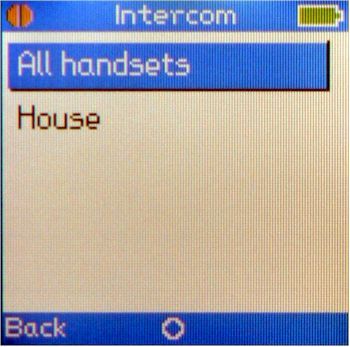
Figure 7: The intercom function supports calling one or all handsets
SIP URIs
At the very cutting edge of VoIP is a group of people who exchange contact details in the form of SIP URIs. As opposed to the 10 digit numbers common on traditional PSTN lines, SIP URIs use a format similar to an email address. For example, [email protected] is an actual SIP URI that points to my personal line via Junction Networks OnSip hosted PBX.
I was a little disappointed to find that the m3 doesn’t handle SIP URIs, either for dialing or in the contact list. It seems to be just a matter of not having access to alpha characters in the entry screens used for dialing or contact details. I would hope that this would also be addressed in future firmware, although I accept that it’s not a problem for the vast majority of users.
Conclusion
snom has long been a leader in SIP compliance testing with their line of desk phones. Adherence to the SIP standard ensures seamless device interoperability. The m3 has proven itself to be very reliable in this regard. On my office network, it was used with several Aastra and Polycom phones. It never dropped a call when used with a hosted IP-PBX, nor when used with my local Asterisk server.
The basic snom m3 kit with one base and one handset retails for $245, with extra handsets going for another $150 each. It’s priced beyond the range of the common household application, but is more than competitive with other business-class solutions, such as the Aastra 480i CT. It’s also considerably less expensive than the enterprise-class SIP/DECT systems from both Polycom and Aastra.
snom’s m3 is a very capable business-class cordless IP phone system. snom has positioned the phone to appeal to savvy SOHO and small business users. When combined with a hosted IP-PBX, it can provide a complete and compelling solution for non-technical users. For those with greater needs, it’s equally functional as part of an Asterisk installation. The m3 is without question the best cordless IP phone system I’ve tried to date—perhaps good enough to keep me from looking further.

